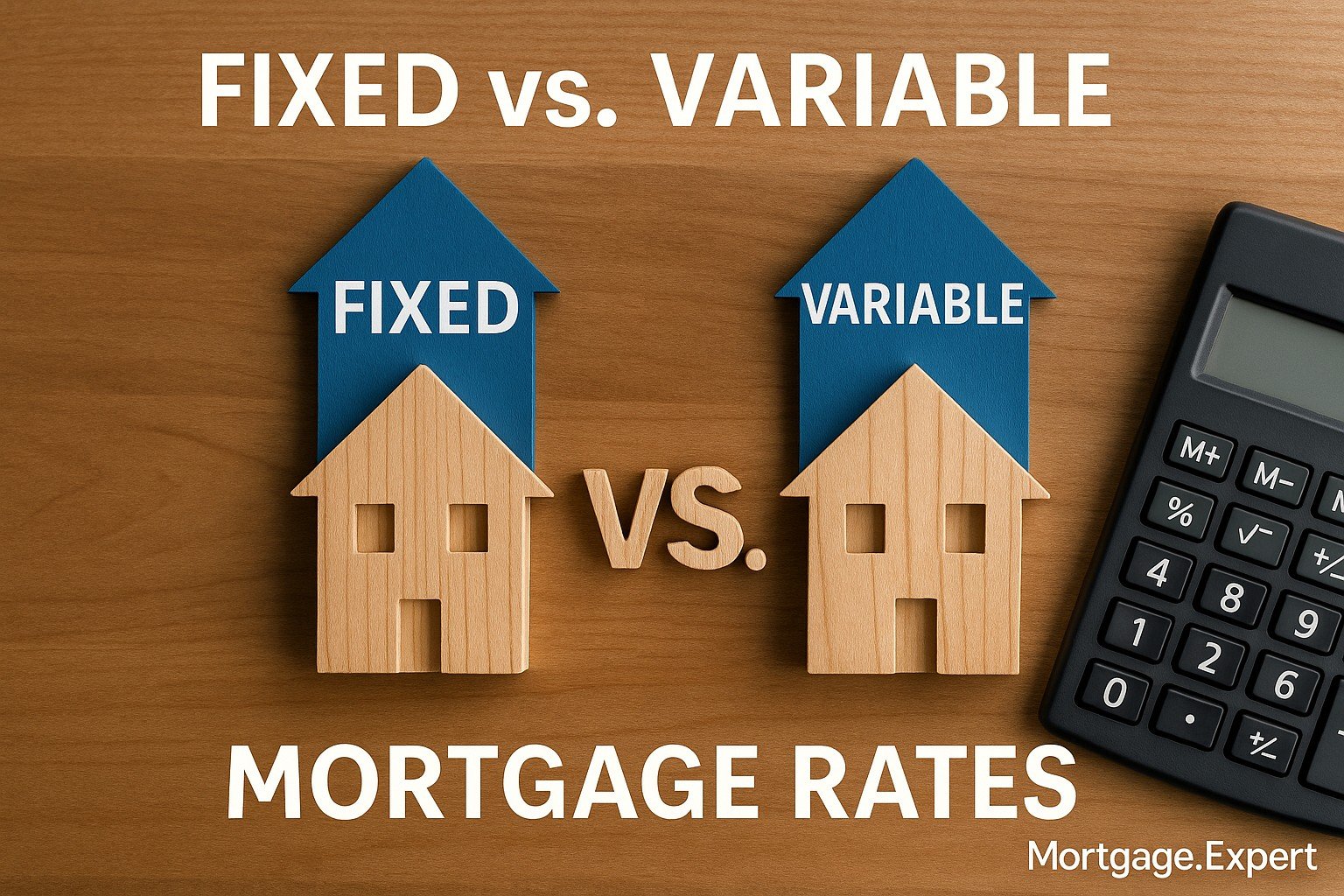
Fixed vs. Variable Mortgage Rates in Canada (2025): What Should You Choose?
Confused between fixed and variable mortgage rates in Canada? Here's a clear 2025 breakdown to help you make the smartest choice for your home loan.
Trying to choose between a fixed and variable mortgage rate? You’re not alone. With interest rates bouncing around, this is one of the biggest decisions Canadian homebuyers and homeowners face in 2025. Let’s walk through the key differences, what they mean in real life, and how you can decide what works best for your financial comfort zone.
What Are Fixed and Variable Mortgage Rates?
A **fixed mortgage rate** stays the same throughout your mortgage term — usually 1 to 5 years. Your monthly payment is predictable, and you won’t be affected by rate hikes.
A **variable mortgage rate**, on the other hand, can change over time. It’s usually tied to the lender’s prime rate. If prime goes up, so can your rate — and your payments, depending on the type of variable mortgage.
How Do They Work in Canada?
In Canada, variable rates are usually offered in two styles:
– **Adjustable-rate mortgages (ARM):** Monthly payments fluctuate as the rate changes.
– **Fixed-payment variable mortgages:** Your payment stays the same, but the portion going toward interest vs. principal changes.
Fixed-rate mortgages are simpler — you lock in a rate and know exactly what your payments will be.
📊 Fixed vs Variable Mortgage – Rate & Payment Comparison (2025)
Wondering whether to go fixed or variable? Here’s a side-by-side comparison for a $500,000 mortgage over a 25-year amortization:
💡 Fixed gives peace of mind. Variable could save money — if rates hold or drop.
Real-Life Example: Fixed vs. Variable for Raj and Meera
Raj and Meera are a couple in Calgary looking to buy their first home. They’re approved for a $600,000 mortgage. Their broker shows them two options:
• Fixed rate: 5.29% for 5 years
• Variable rate: 4.85% with prime currently at 7.20%
They like the savings on the variable option, but they’re nervous about rates rising. After some thinking, they go with variable — but make payments as if they were paying the fixed rate. This way, they reduce principal faster and create a buffer if rates go up.
What Are the Pros and Cons of Each?
**Fixed-rate pros:** Predictability, easier budgeting, peace of mind during rate hikes.
**Fixed-rate cons:** Higher starting rate, penalties if you break early can be severe (often the Interest Rate Differential).
**Variable-rate pros:** Historically lower rates over time, smaller penalties if you break early (3 months’ interest).
**Variable-rate cons:** Uncertainty, especially in volatile rate environments. Trigger rate risk for fixed-payment variable mortgages.
⚖️ Pros & Cons: Fixed vs Variable Mortgage (2025)
Not sure which mortgage type is right for you? Here’s a quick look at the benefits and trade-offs of fixed vs variable rates.
💡 Tip: Variable rates tend to win in the long term, but fixed rates offer peace of mind in volatile markets.
What Is the Trigger Rate in a Variable Mortgage?
If you choose a variable mortgage with fixed payments, the **trigger rate** is the point where your payments aren’t even covering the interest anymore. Once you hit that, the lender might increase your payment or convert the mortgage.
This caught many Canadians off guard in 2022–2023 when rates spiked. If you’re choosing variable, understand this risk.
What Happens If Interest Rates Keep Rising?
If rates go up, variable-rate holders could see their monthly payments increase or their amortization stretch longer. If rates go down, they benefit by paying less interest.
Fixed-rate borrowers are protected from this — but they can’t take advantage of falling rates unless they refinance, which often comes with a hefty penalty.
Can You Switch Between Fixed and Variable Later?
Yes — if you start with a variable-rate mortgage, many lenders let you **lock in** to a fixed rate anytime. But that fixed rate will be the current posted rate at that time, not what you were offered originally.
Switching from fixed to variable mid-term is less common and usually involves breaking your mortgage (and paying penalties).
What About Hybrid or Convertible Mortgages?
Some lenders offer **hybrid mortgages** — part fixed, part variable. It gives you the stability of fixed with the flexibility of variable. There are also **convertible mortgages**, which start variable and let you lock into fixed later without breaking the term.
These products aren’t as common, but can be a great middle-ground for those unsure about committing to one or the other.
Which Is Better in 2025?
That depends on your comfort with risk, your financial flexibility, and where rates are headed.
If you value certainty and can’t handle higher payments, go fixed. If you’re okay with some fluctuation and want to potentially save, go variable — and plan wisely.
Talk to your mortgage broker. They’ll help assess your goals, budget, and even simulate future rate scenarios to help you decide.
📈 Rate Forecast: Bank of Canada vs Mortgage Rates (2015–2025)
A decade of interest rate movements: How the Bank of Canada’s policy rate has influenced variable and fixed mortgage rates across Canada.
💡 Fixed rates follow bond yields; variable rates follow the BoC. Past performance shows sharp moves post-pandemic and in 2023–2024 inflation recovery.
Final Thoughts from a Mortgage Expert
Fixed vs. variable isn’t about right or wrong — it’s about what fits you best. In 2025, rates are still unpredictable. Make your decision based on how much peace of mind you want, how long you plan to stay in the home, and how much flexibility your budget allows.
And remember — whichever you choose, staying informed and reviewing your mortgage yearly is key to staying ahead.
Stuck with a Mortgage Decision?
Don’t stress — our team is here to help. Reach out for free, no-obligation guidance.
Contact the Experts

